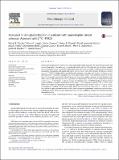Increased in vivo glial activation in patients with amyotrophic lateral sclerosis: Assessed with [11C]-PBR28

View/
Author
Zürcher, Nicole R.
Lawson, Robert
Yasek, Julia E.
Akeju, Oluwaseun
Atassi, Nazem
Note: Order does not necessarily reflect citation order of authors.
Published Version
https://doi.org/10.1016/j.nicl.2015.01.009Metadata
Show full item recordCitation
Zürcher, N. R., M. L. Loggia, R. Lawson, D. B. Chonde, D. Izquierdo-Garcia, J. E. Yasek, O. Akeju, et al. 2015. “Increased in vivo glial activation in patients with amyotrophic lateral sclerosis: Assessed with [11C]-PBR28.” NeuroImage : Clinical 7 (1): 409-414. doi:10.1016/j.nicl.2015.01.009. http://dx.doi.org/10.1016/j.nicl.2015.01.009.Abstract
Evidence from human post mortem, in vivo and animal model studies implicates the neuroimmune system and activated microglia in the pathology of amyotrophic lateral sclerosis. The study aim was to further evaluate in vivo neuroinflammation in individuals with amyotrophic lateral sclerosis using [11C]-PBR28 positron emission tomography. Ten patients with amyotrophic lateral sclerosis (seven males, three females, 38–68 years) and ten age- and [11C]-PBR28 binding affinity-matched healthy volunteers (six males, four females, 33–65 years) completed a positron emission tomography scan. Standardized uptake values were calculated from 60 to 90 min post-injection and normalized to whole brain mean. Voxel-wise analysis showed increased binding in the motor cortices and corticospinal tracts in patients with amyotrophic lateral sclerosis compared to healthy controls (pFWE < 0.05). Region of interest analysis revealed increased [11C]-PBR28 binding in the precentral gyrus in patients (normalized standardized uptake value = 1.15) compared to controls (1.03, p < 0.05). In patients those values were positively correlated with upper motor neuron burden scores (r = 0.69, p < 0.05), and negatively correlated with the amyotrophic lateral sclerosis functional rating scale (r = –0.66, p < 0.05). Increased in vivo glial activation in motor cortices, that correlates with phenotype, complements previous histopathological reports. Further studies will determine the role of [11C]-PBR28 as a marker of treatments that target neuroinflammation.Other Sources
http://www.ncbi.nlm.nih.gov/pmc/articles/PMC4310932/pdf/Terms of Use
This article is made available under the terms and conditions applicable to Other Posted Material, as set forth at http://nrs.harvard.edu/urn-3:HUL.InstRepos:dash.current.terms-of-use#LAACitable link to this page
http://nrs.harvard.edu/urn-3:HUL.InstRepos:14065310
Collections
- FAS Scholarly Articles [18304]
- HMS Scholarly Articles [17937]
Contact administrator regarding this item (to report mistakes or request changes)


